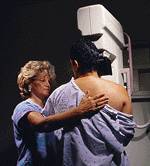
MONDAY, April 30 (HealthDay News) — A new analysis that may help women in their 40s interpret mammogram guidelines says those with a family history of breast cancer or extremely dense breast tissue should start getting regular screenings.
The benefits of getting a mammogram every two years outweigh the risks for these particular women, who are at increased risk for developing breast cancer, according to the U.S. National Cancer Institute-funded study.
“Among a group of women who have twice the average level of risk, screening every other year starting at age 40 has the same balance of benefit and harms as starting at age 50,” said researcher Dr. Jeanne Mandelblatt, associate director for population sciences at Georgetown Lombardi Comprehensive Cancer Center in Washington, D.C.
The research is published May 1 in the Annals of Internal Medicine.
Experts currently disagree on the recommended frequency of screenings and the intervals between them. In 2009, the U.S. Preventive Services Task Force ignited debate when it recommended screening mammograms every two years for women ages 50 to 74. It advised women in their 40s at average risk of breast cancer to discuss the pros and cons with their doctors and then decide about the value of screening. Other organizations, including the American Cancer Society, continue to advise women 40 and older to get yearly screening mammograms.
The task force made the recommendations after it found that mammograms every two years in average-risk women in their 40s posed considerable harms, such as false-positive results causing anxiety or leading to unneeded invasive procedures.
For this study, Mandelblatt and her colleagues set out to identify specific factors that increased breast cancer risk for women ages 40 to 49. To do so, they evaluated data from 66 published articles and from the cancer institute’s Breast Cancer Surveillance Consortium.
Of 13 possible risk factors, they found extremely dense breast tissue or a first-degree relative with breast cancer (parent, sibling or child) doubled the risk of breast cancer in women 40 to 49. Breast density is determined through by mammography.
About 13 percent of women in their 40s have extremely dense breast tissue and 9 percent have a first-degree relative with breast cancer.
Next, they performed a technique called collaborative modeling to estimate the harms and benefits of every-other-year mammography for these under-50, high-risk women.
Researchers put together four independent models to see if a doubling of risk changed the balance of harms and benefits.
All four models concluded that higher-risk women 40 to 49 who start every-other-year screenings at age 40 have the same benefit-harm ratio as average-risk women 50 to 74 who have mammograms every two years.
“Our models don’t say what they [women] should do,” Mandelblatt said. The conclusions will help inform women and professional organizations that formulate recommendations, the experts said.
The researchers found small differences in benefits between film mammography and the newer digital mammography. The digital forms had more false-positives.
In digital mammograms, the breast image is electronic and stored in the computer rather than on film.
The new research confirms some of what experts already know, said Judith Malmgren, an affiliate assistant professor of epidemiology at the University of Washington, in Seattle. “We already knew that women with a family history of breast cancer should start screening at age 40,” she said.
The new data “shows the balance [of harms and benefits] more conclusively,” she said.
However, modeling studies aren’t real life, so they have limitations, she said.
The models took into account life years gained and breast cancer deaths averted, as well as potential harms, she said. “The model doesn’t take into account that earlier stage at detection requires less treatment,” she said.
In an editorial accompanying the research, Dr. Otis Brawley of the American Cancer Society writes that risk-based screening — zeroing in on those at higher risk — can focus on the women most likely to benefit.
In the future, he predicts more emphasis will be placed on risk-based screening. “Ultimately, the preferences of individual women, recognizing the potential for harm and benefit, should be respected,” he said.
More information
The American Cancer Society has more about mammograms.

